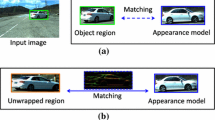Abstract
We describe how to model the appearance of a 3-D object using multiple views, learn such a model from training images, and use the model for object recognition. The model uses probability distributions to describe the range of possible variation in the object's appearance. These distributions are organized on two levels. Large variations are handled by partitioning training images into clusters corresponding to distinctly different views of the object. Within each cluster, smaller variations are represented by distributions characterizing uncertainty in the presence, position, and measurements of various discrete features of appearance. Many types of features are used, ranging in abstraction from edge segments to perceptual groupings and regions. A matching procedure uses the feature uncertainty information to guide the search for a match between model and image. Hypothesized feature pairings are used to estimate a viewpoint transformation taking account of feature uncertainty. These methods have been implemented in an object recognition system, OLIVER. Experiments show that OLIVER is capable of learning to recognize complex objects in cluttered images, while acquiring models that represent those objects using relatively few views.
Similar content being viewed by others
References
Ayache, N. and Faugeras, O.D. 1986. HYPER: A new approach for the recognition and positioning of two-dimensional objects. IEEE Trans. Pattern Analysis and Machine Intelligence, PAMI-8(1):44–54.
Beis, J.S. and Lowe, D.G. 1999. Indexing without invariants in 3D object recognition. IEEE Trans. Pattern Analysis and Machine Intelligence, 21(10):1000–1015.
Bierman, G.J. 1977. Factorization Methods for Discrete Sequential Estimation. Academic Press: NewYork.
Bolles, R.C. and Cain, R.A. 1982. Recognizing and locating partially visible objects: The local-feature-focus method. Int. J. of Robotics Research, 1(3):57–82.
Breuel, T.M. 1992. Geometric aspects of visual object recognition. Ph.D. thesis, Mass. Inst. Technol.
Brooks, R.A. 1981. Symbolic reasoning among 3-D models and 2-D images. Artificial Intelligence, 17:285–348.
Burl, M.C., Weber, M., and Perona, P. 1998. Aprobabilistic approach to object recognition using local photometry and global geometry. In Proc. European Conf. on Computer Vision, pp. 628–641.
Burns, J.B. and Riseman, E.M. 1992. Matching complex images to multiple 3D objects using view description networks. In Proc. Conf. Computer Vision and Pattern Recognition, pp. 328–334.
Fisher, D.H. 1987. Knowledge acquisition via incremental conceptual clustering. Machine Learning, 2:139–172.
Grimson,.E.L. and Lozano-Pérez, T. 1987. Localizing overlapping parts by searching the interpretation tree. IEEE Trans. Pattern Analysis and Machine Intelligence, 9(4):469–482.
Hel-Or, Y. and Werman, M. 1995. Pose estimation by fusing noisy data of different dimensions. IEEE Trans. Pattern Analysis and Machine Intelligence, 17(2):195–201.
Huttenlocher, D.P. and Ullman, S. 1990. Recognizing solid objects by alignment with an image. International Journal of Computer Vision, 5(2):195–212.
Lowe, D.G. 1985. Perceptual Organization and Visual Recognition. Kluwer: Dordrecht.
Lowe, D.G. 1987. Three-dimensional object recognition from single two-dimensional images. Artificial Intelligence, 31:355–395.
Murase, H. and Nayar, S.K. 1995. Visual learning and recognition of 3D objects from appearance. International Journal of Computer Vision, 14(1):5–24.
Nelson, R.C. and Selinger, A. 1998. A cubist approach to object recognition. In Proc. Int. Conf. Computer Vision, pp. 614–621.
Petitjean, S., Ponce, J., and Kriegman, D.J. 1992. Computing exact aspect graphs of curved objects: Algebraic surfaces. International Journal of Computer Vision, 9(3):231–255.
Pope, A.R. 1995. Learning to recognize objects in images: Acquiring and using probabilistic models of appearance. Ph.D. thesis, Computer Science Dept., Univ. of British Columbia.
Pope, A.R. and Lowe, D.G. 1994. Vista: A software environment for computer vision research. In Proc. Conf. Computer Vision and Pattern Recognition, pp. 768–772.
Rissanen, J. 1983. A universal prior for integers and estimation by minimum description length. Annals of Statistics, 11(2):416–431.
Roberts, L.G. 1965. Machine perception of three-dimensional solids. In Optical and Electro-Optical Information Processing, J. Tippett (Ed.). MIT Press, pp. 159–197.
Schiele, B. and Crowley, J. 1996. Object recognition using multidimensional receptive field histograms. In Fourth European Conference on Computer Vision, Cambridge, UK, pp. 610–619.
Schmid, C. and Mohr, R. 1997. Local grayvalue invariants for image retrieval. IEEE Trans. Pattern Analysis and Machine Intelligence, 19(5):530–534.
Swain, M. and Ballard, D. 1991. Color indexing. International Journal of Computer Vision, 7(1):11–32.
Ullman, S. and Basri, R. 1991. Recognition by linear combination of models. IEEE Trans. Pattern Analysis and Machine Intelligence, 13(10):992–1006.
Van Huffel, S. and Vandewalle, J. 1991. The Total Least Squares Problem: Computational Aspects and Analysis, Vol. 9 of Frontiers in Applied Mathematics. Philadelphia: Soc. for Industrial and Applied Mathematics.
Wells III, W.M. 1997. Statistical approaches to feature-based object recognition. International Journal of Computer Vision, 21(1/2):63–98.
Author information
Authors and Affiliations
Rights and permissions
About this article
Cite this article
Pope, A.R., Lowe, D.G. Probabilistic Models of Appearance for 3-D Object Recognition. International Journal of Computer Vision 40, 149–167 (2000). https://doi.org/10.1023/A:1026502202780
Issue Date:
DOI: https://doi.org/10.1023/A:1026502202780




